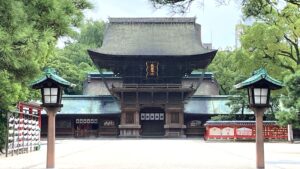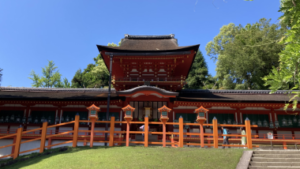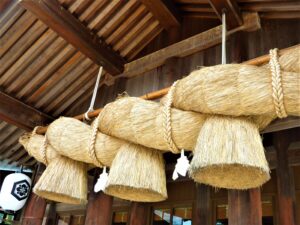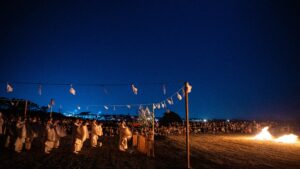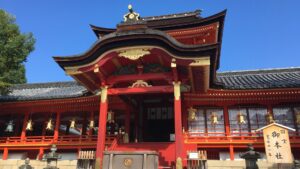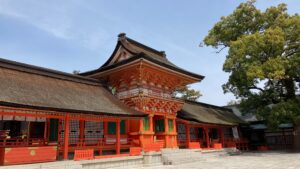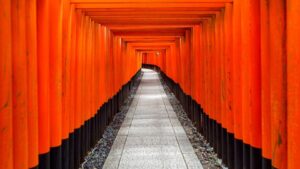Ise Jingu Shrine, Geku First and Then NaikuNew!!
Ise Jingu Shinto Shrine (伊勢神宮), officially called Jingu, consists of 125 Shinto shrines. Crossing the Uji Bridge over the Isuzu River at the entrance of a main shrine, Kotaijingu (Naiku), you are in a sacred world where the deities dwell. As you walk the pea gravel approach along the giant cedar trees, you may feel […]
Hakozakigu Shrine, Brings Victory and Good Luck
Hakozakigu Shrine in Fukuoka prefecture, Brings Victory and Good Luck
Kasugataisha: A 1,300-Year-Old Sacred Shrine in Nara
Kasgataisha Shrine in Nara has a 1300-year-old history. Feeling the spituality from the sacred deer, mountains, and forests, the all are the divinity of Kasuga's God.
Suwa Taisha Shrine: Jomon People's Sprits still Remains
The Onbashira Matsuri Festival is a unique and sacred ritual ceremony held once every seven years at Suwa Taisha Shrine with a long and rich history of at least 1200 years and more. The festival is centered around the transportation of massive sixteen-fir sacred wooden pillars with all branches removed (Onbashira). These 10-ton pillars are […]
Izumo Taisha Shrine: Mystical Secrets of Izumo's Spiritual Power
Izumo holds a special place in Japanese history starting mythological ancient times. Several reasons: The largest Shimenawa, sacred straw ropes, in Japan, the largest Main Shrine in ancient times, the Kamiarisai Festival in October of the lunar calendar, where deities from across Japan gather in Izumo, the largest Bronze bell-shaped vessels and Bronze Swords in […]
Izumo Taisha Shrine: The Heart of the Japanese People at Kamiari-sai Festival
The Kamiari-sai is an annual festival held at Izumo Taisha Shrine, taking place in October according to the lunar calendar. In the year 2023, it’s scheduled from November 22nd to the 29th. The festival is staged to welcome the deities from the nation, and it commences at Inasa-Hama shore, which is situated approximately a 20-minute […]
Why did So Many Emperors, Court Nobles, and Samurai visit the Iwashimizu Hachimangu Shrine?
In the year 860, the Iwashimizu Hachimangu Shrine was established by an oracle who voiced a fervent wish to stand in proximity to the Imperial palace, safeguarding the nation. Thus, the venerated Hachiman deity was enshrined as a national guardian deity in Kyoto along the head shrine of Hachiman Okami, Usa Jingu Shrine in Kyushu. […]
The History of Hachiman Deity Worshipped at Usa Jingu Shrine, Protecting Japan and Samurai
Usa Jingu is the head shrine of approximately 460,000 Hachimangu shrines, out of a total of 110,000 shrines in Japan. This makes it the largest number in Japan. The three major Hachimangu shrines are Usa Jingu in Kyushu, Hakozakigu in Kyushu, and Iwashimizu Hachimangu in Kyoto. The deity worshipped at Usa Jingu Shrine, Hachiman Omikami, […]
Takayama Festival (Spring and Autumn), Keep your eyes on Karakuri doll’s performance
In Spring, the Karakuri doll scatters a lot of cherry blossoms to commemorate the arrival of spring. In Autumn, one small Karakuri doll moves by hanging and moving across several bars one by one riding piggyback on the Hotei, who is known as a deity of good luck. People watch its success breathlessly. Once it […]
Fushimi Inari Taisha Shrine, 5,000 Vermillion Torii Gates
Fushimi Inari Taisha Shrine is one of the most notable Shinto shrines located at the foot of Mount Inari, which is considered sacred as a whole, in southern Kyoto. It is the head of over 30,000 Inari shrines across the nation that are prayed to for a good harvest. A grain deity named Ukano-mitama, also […]


